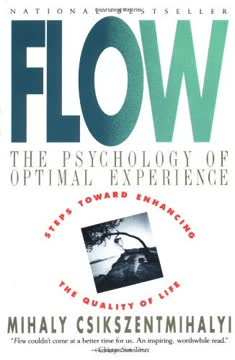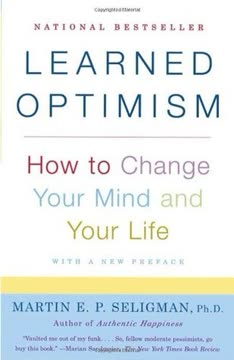Key Takeaways
1. Positive emotions broaden our perspective and build lasting resources
Positive emotion emanating from a child is a neon sign that identifies a winning situation for the child and the parents alike.
Evolutionary purpose. Positive emotions serve a crucial evolutionary function. Unlike negative emotions, which narrow our focus to deal with immediate threats, positive emotions broaden our awareness and encourage exploration. This expanded perspective allows us to build lasting personal resources - intellectual, social, and physical.
The broaden-and-build theory. Barbara Fredrickson's research shows that positive emotions:
- Enhance creativity and problem-solving
- Improve relationships and social connections
- Build resilience and coping skills
- Contribute to better physical health
Upward spiral. Experiencing positive emotions leads to more positive experiences, creating an upward spiral of well-being. This cycle reinforces itself, making it easier to experience positive emotions in the future and building long-term emotional resources.
2. Happiness has a genetic set point, but we can influence it
H=S+C+V
Happiness formula. Seligman proposes that our enduring level of happiness (H) is determined by:
- Set range (S): Our genetic predisposition, accounting for about 50% of happiness
- Circumstances (C): External factors like wealth, health, and relationships, contributing about 10%
- Voluntary activities (V): Actions we choose to take, accounting for about 40%
Hedonic adaptation. We quickly adapt to changes in our circumstances, both good and bad. This explains why major life events often have less long-term impact on happiness than we expect.
Strategies for lasting change. To increase happiness beyond our set range:
- Focus on voluntary activities that align with our values and strengths
- Engage in practices that combat hedonic adaptation, like savoring and gratitude
- Cultivate meaningful relationships and pursue personal growth
3. Gratitude and forgiveness enhance satisfaction with the past
By amplifying good memories about the past: their intensity, their frequency, and the tag lines the memories have.
Reframing the past. Our satisfaction with the past is determined by how we interpret our memories, not by the events themselves. Gratitude and forgiveness are powerful tools for reframing our past experiences positively.
Gratitude practices:
- Keep a gratitude journal
- Write a letter of thanks to someone who influenced you positively
- Share three good things that happened each day with a partner
Forgiveness strategies:
- Practice empathy for the offender
- Recognize the personal benefits of forgiving
- Use the REACH model: Recall, Empathize, Altruistic gift, Commit, Hold onto forgiveness
By cultivating gratitude and forgiveness, we can transform bitter memories into sources of strength and wisdom, increasing our overall life satisfaction.
4. Optimism and hope fuel happiness about the future
People who make universal explanations for their failures give up on everything when a failure strikes in one area. People who make specific explanations may become helpless in that one part of their lives, yet march stalwartly on in the others.
Explanatory style. Our happiness about the future is largely influenced by our explanatory style - how we interpret good and bad events. Optimists tend to see negative events as temporary, specific, and external, while pessimists see them as permanent, pervasive, and personal.
Benefits of optimism:
- Better physical and mental health
- Greater resilience in face of adversity
- Higher achievement in work and academics
- Improved relationships
Learned optimism. Optimism can be cultivated through techniques like:
- Disputing negative thoughts
- Considering alternative explanations for events
- Focusing on changeable aspects of situations
- Practicing future-minded thinking and goal-setting
By developing a more optimistic outlook, we can increase our happiness about the future and improve our ability to cope with challenges.
5. Flow experiences create happiness in the present
Flow cannot be sustained through an entire eight-hour workday; rather, under the best of circumstances, flow visits you for a few minutes on several occasions.
Characteristics of flow. Flow is a state of complete absorption in an activity, characterized by:
- Clear goals and immediate feedback
- Balance between challenge and skill
- Loss of self-consciousness
- Distorted sense of time
- Intrinsic reward
Benefits of flow:
- Increased productivity and creativity
- Enhanced learning and skill development
- Greater sense of fulfillment and life satisfaction
- Improved mental health and well-being
Cultivating flow. To experience more flow in daily life:
- Identify activities that naturally engage you
- Set clear goals and seek immediate feedback
- Gradually increase the challenge as your skills improve
- Minimize distractions and create a conducive environment
- Focus on the process, not just the outcome
By intentionally seeking out and creating more flow experiences, we can increase our happiness in the present moment and lead more fulfilling lives.
6. Identify and use your signature strengths daily
Using your signature strengths every day in the main realms of your life to bring abundant gratification and authentic happiness.
VIA Character Strengths. The Values in Action (VIA) Classification identifies 24 universal character strengths organized under six virtues: wisdom, courage, humanity, justice, temperance, and transcendence.
Signature strengths. These are your top 5-7 character strengths that feel most authentic and energizing to you. They are:
- Essential to who you are
- Energizing when used
- Easy to learn and apply
- Frequently used across different contexts
Benefits of using signature strengths:
- Increased happiness and life satisfaction
- Better work performance and engagement
- Improved relationships
- Enhanced ability to cope with stress and adversity
To leverage your signature strengths:
- Take the VIA Character Strengths Survey
- Identify ways to use your top strengths more often in work, relationships, and leisure
- Craft your job or daily activities to align with your strengths
- Share your strengths with others and seek opportunities for strength-based collaboration
7. Create more gratifications, not just pleasures, in life
A calling is the most satisfying form of work because, as a gratification, it is done for its own sake rather than for the material benefits it brings.
Pleasures vs. Gratifications. Seligman distinguishes between two types of positive experiences:
- Pleasures: Sensory and emotional delights (e.g., eating, relaxing)
- Gratifications: Engaging activities that create flow (e.g., sports, hobbies)
Characteristics of gratifications:
- Require effort and skill
- Create a sense of accomplishment
- Often involve serving a greater purpose
- Lead to personal growth and development
Strategies for increasing gratifications:
- Identify activities that challenge and engage you
- Set goals that align with your values and strengths
- Seek opportunities for meaningful service or contribution
- Cultivate relationships that support your personal growth
- Transform routine tasks into opportunities for flow
By prioritizing gratifications over mere pleasures, we can create a more fulfilling and meaningful life, leading to lasting happiness and personal growth.
8. Nurture positive emotions and strengths in children
Evolution has seen to it that when young organisms are safe, they feel positive emotion, and they will reach outward and broaden their resources by exploring and playing.
Importance of positive emotions. Positive emotions in children are crucial for:
- Encouraging exploration and learning
- Building resilience and coping skills
- Developing social connections
- Fostering creativity and problem-solving abilities
Strategies for nurturing positive emotions:
- Create a safe and supportive environment
- Encourage play and exploration
- Model positive emotional expression
- Praise effort and specific actions, not just outcomes
- Help children identify and label their emotions
Cultivating character strengths. To help children develop their strengths:
- Observe and appreciate their natural inclinations
- Provide opportunities to practice and develop various strengths
- Help them identify their signature strengths
- Encourage the use of strengths in facing challenges
- Celebrate when they use their strengths effectively
By focusing on positive emotions and strengths, we can help children build the resources they need for lifelong well-being and success.
9. Secure attachment and synchrony games build resilience in kids
The key to disputing your own pessimistic thoughts is to first recognize them and then to treat them as if they were uttered by an external person, a rival whose mission in life was to make you miserable.
Secure attachment. A strong, loving bond between parent and child provides:
- A sense of safety and security
- Confidence to explore the world
- Better emotional regulation
- Improved social skills and relationships
Synchrony games. These are simple, reciprocal interactions that teach children their actions matter. Benefits include:
- Enhanced sense of agency and control
- Improved cognitive development
- Stronger parent-child bond
- Better communication skills
Examples of synchrony games:
- Peek-a-boo
- Mimicking facial expressions
- Call-and-response songs
- Turn-taking games
By fostering secure attachment and playing synchrony games, parents can help build their children's resilience, self-esteem, and ability to form healthy relationships throughout life.
10. Praise effort and specific actions, not just outcomes
Unconditional positive regard means paying affectionate attention regardless of how good or bad the behavior is.
Benefits of effective praise:
- Builds intrinsic motivation
- Encourages perseverance
- Fosters a growth mindset
- Improves self-esteem and confidence
Guidelines for effective praise:
- Be specific about what you're praising
- Focus on effort, strategies, and progress
- Avoid comparisons to others
- Be sincere and genuine
- Use a warm, encouraging tone
Examples:
- Instead of "You're so smart!" try "I'm impressed by how hard you worked on that problem."
- Rather than "Good job!" say "I noticed how you kept trying different approaches until you found one that worked."
By praising effort and specific actions, we help children develop resilience, a love of learning, and the confidence to tackle new challenges.
11. Combat sibling rivalry by highlighting each child's unique strengths
Each child wants to feel important, trusted, and irreplaceably special. When any of these wants is threatened, rivalry takes root easily.
Causes of sibling rivalry:
- Competition for parental attention and resources
- Feelings of favoritism or unfairness
- Differences in age, abilities, or temperament
Strategies to reduce rivalry:
- Recognize and appreciate each child's unique qualities
- Avoid comparisons between siblings
- Spend one-on-one time with each child
- Encourage cooperation rather than competition
- Teach conflict resolution skills
Strength-based approach:
- Help each child identify their signature strengths
- Create opportunities for each child to showcase their strengths
- Assign household responsibilities based on individual strengths
- Celebrate each child's unique contributions to the family
By focusing on each child's unique strengths and contributions, parents can foster a sense of individual worth and reduce competition between siblings, creating a more harmonious family dynamic.
Last updated:
FAQ
What's Authentic Happiness about?
- Focus on Positive Psychology: Authentic Happiness by Martin E.P. Seligman delves into Positive Psychology, which emphasizes enhancing positive emotions, strengths, and virtues rather than just treating mental illness.
- Three Pillars of Happiness: The book outlines three main pillars: positive emotions, positive traits (strengths and virtues), and positive institutions that support these traits.
- Path to Fulfillment: Seligman argues that true happiness comes from identifying and cultivating personal strengths, leading to a more fulfilling life.
Why should I read Authentic Happiness?
- Scientific Approach: The book is grounded in scientific research, offering evidence-based strategies for increasing happiness and well-being.
- Practical Applications: It provides practical exercises and methods, such as the "Gratitude Night," that readers can implement to enhance their happiness.
- Transformative Insights: Seligman challenges traditional views on happiness, encouraging readers to rethink their beliefs and achieve profound personal transformation.
What are the key takeaways of Authentic Happiness?
- Happiness is Trainable: Happiness can be increased through intentional practices and understanding one's strengths, countering the belief that it is a fixed trait.
- Importance of Strengths: Identifying and utilizing personal strengths is crucial for achieving authentic happiness, leading to greater engagement and fulfillment.
- Positive Emotions Matter: Cultivating positive emotions can buffer against negative experiences and enhance overall well-being.
What are the best quotes from Authentic Happiness and what do they mean?
- "Authentic happiness comes from identifying and cultivating your most fundamental strengths.": This underscores the book's central theme that true happiness is derived from leveraging one's unique strengths.
- "The pursuit of happiness is enshrined in the Declaration of Independence.": Seligman connects happiness to foundational American values, suggesting it is a fundamental human right.
- "Positive Psychology takes seriously the bright hope that if you find yourself stuck in the parking lot of life... there is a road out.": This conveys that there are actionable paths to improve one's happiness even in difficult times.
What is the Happiness Formula in Authentic Happiness?
- Components of Happiness: Seligman presents the formula H = S + C + V, where H is happiness, S is the set range (genetic predisposition), C represents life circumstances, and V stands for voluntary factors.
- Set Range: About 50% of our happiness is determined by genetics, suggesting inherent limits based on biological makeup.
- Voluntary Factors: Individuals can actively work on their happiness through practices like gratitude and optimism, leading to lasting changes.
How can I increase my positive emotions according to Authentic Happiness?
- Practice Gratitude: Keeping a gratitude journal or engaging in "Gratitude Night" can enhance overall happiness by appreciating life's positive aspects.
- Mindfulness and Savoring: Engaging in mindfulness and savoring positive experiences helps individuals fully appreciate joyful moments.
- Dispute Negative Thoughts: Recognizing and disputing pessimistic thoughts, replacing them with optimistic beliefs, fosters a more positive emotional state.
What are signature strengths and how do they relate to happiness?
- Definition of Signature Strengths: These are unique qualities and abilities individuals possess, identifiable through assessments like the VIA Survey of Character Strengths.
- Utilizing Strengths: Using these strengths in daily life can lead to greater engagement and fulfillment, enhancing happiness.
- Connection to Authentic Happiness: Focusing on and cultivating these strengths creates a more meaningful and satisfying life.
How does Authentic Happiness address the concept of forgiveness?
- Forgiveness as a Tool: Seligman discusses forgiveness as a method for releasing negative emotions tied to past grievances, increasing life satisfaction.
- Impact on Happiness: Forgiveness can transform bitterness into positive memories, allowing individuals to move forward and experience greater happiness.
- Practical Exercises: The book provides exercises for cultivating forgiveness, encouraging reflection and letting go of grudges.
What role does optimism play in achieving happiness according to Authentic Happiness?
- Optimism Defined: Seligman defines optimism as expecting positive outcomes and viewing challenges as temporary and specific.
- Benefits of Optimism: Optimistic individuals tend to have better mental health, greater resilience, and higher life satisfaction.
- Building Optimism: Strategies include disputing negative thoughts and focusing on positive experiences, leading to a hopeful outlook.
What are the main concepts of Positive Psychology in Authentic Happiness?
- Pleasant Life vs. Good Life: The pleasant life focuses on momentary pleasures, while the good life emphasizes using strengths for deeper gratification.
- Meaningful Life: Serving a purpose greater than oneself leads to profound fulfillment and connection.
- Broaden-and-Build Theory: Positive emotions broaden awareness and encourage exploratory thoughts and actions, building personal resources over time.
How does Seligman define happiness in Authentic Happiness?
- Three Dimensions of Happiness: Happiness is defined through the pleasant life (positive feelings), the good life (engagement through strengths), and the meaningful life (purpose and contribution).
- Authentic Happiness: It involves a deeper sense of fulfillment from living in accordance with one’s values and strengths.
- Subjective Well-Being: Measured through life satisfaction, positive moods, and the absence of negative moods.
How can I apply the concepts from Authentic Happiness in my daily life?
- Daily Practices: Incorporate gratitude journaling, mindfulness exercises, and identification of personal strengths into your routine.
- Engage in Meaningful Activities: Seek activities that align with your signature strengths and values, fostering purpose and fulfillment.
- Cultivate Positive Relationships: Focus on building strong social connections, as they are key to lasting happiness and well-being.
Review Summary
Authentic Happiness receives mostly positive reviews, praised for its scientific approach to positive psychology and practical advice on increasing happiness. Readers appreciate Seligman's focus on strengths and virtues, though some find the writing style dry. The book's tests and exercises are generally well-received, but a few reviewers criticize its optimistic outlook and capitalistic leanings. Many readers find the concepts of gratitude, forgiveness, and flow particularly insightful. Overall, the book is seen as a valuable resource for understanding and improving one's well-being.
Similar Books










Download PDF
Download EPUB
.epub digital book format is ideal for reading ebooks on phones, tablets, and e-readers.







